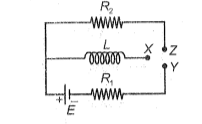A direct current of \(2~\text{A}\) and an alternating current having peak value \(2~\text{A}\) flow through two identical resistances at the same time. The ratio of heat produced in the two resistance will be:
1. \(1:1\)
2. \(1:2\)
3. \(2:1\)
4. \(4:1\)
1. \(1:1\)
2. \(1:2\)
3. \(2:1\)
4. \(4:1\)
The inductive reactance and resistance of the L-R circuit are respectively 30 ohm and 40 ohm. The impedance of the circuit is
1. 50 ohm
2. 10 ohm
3. 70 ohm
4. ohm
A bulb and a capacitor are in series with an A.C. source. On increasing frequency, how will the glow of the bulb change?
1. The glow decreases
2. The glow increases
3. The glow remains the same
4. The glow first decreases then increases
In the circuit shown, X is joining to Y for a long time, and then X is joined to Z. The total heat produced in is ( symbols have their usual meaning)

A transformer has a turn ratio of 1: 5. A DC source of EMF 10 V is applied across its primary. EMF across the secondary will be
1. 50 V
2. 2 V
3. zero
4. 100 V
A series LCR circuit has resistance 2 and self inductance 20 mH. Bandwidth of the circuit is (in radian/s)
1. 1000
2. 100
3. 10
4.
Voltage across the resistor, inductor and capacitor in series LCR circuit are 20 V, 50 V and 50 V respectively. Peak value of the applied source is
1. 20 V
2. 20 V
3. 120 V
4. 120 V
The r.m.s value of current for
1. 5 A
2. 5 A
3.
4.
If and are half power frequencies of a series LCR circuit, then resonant frequency can be expressed as
Hence:
| 1. | The voltage leads the current by \(30^{\circ}\). |
| 2. | The current leads the voltage by \(30^{\circ}\). |
| 3. | The current leads the voltage by \(60^{\circ}\). |
| 4. | The voltage leads the current by \(60^{\circ}\). |






